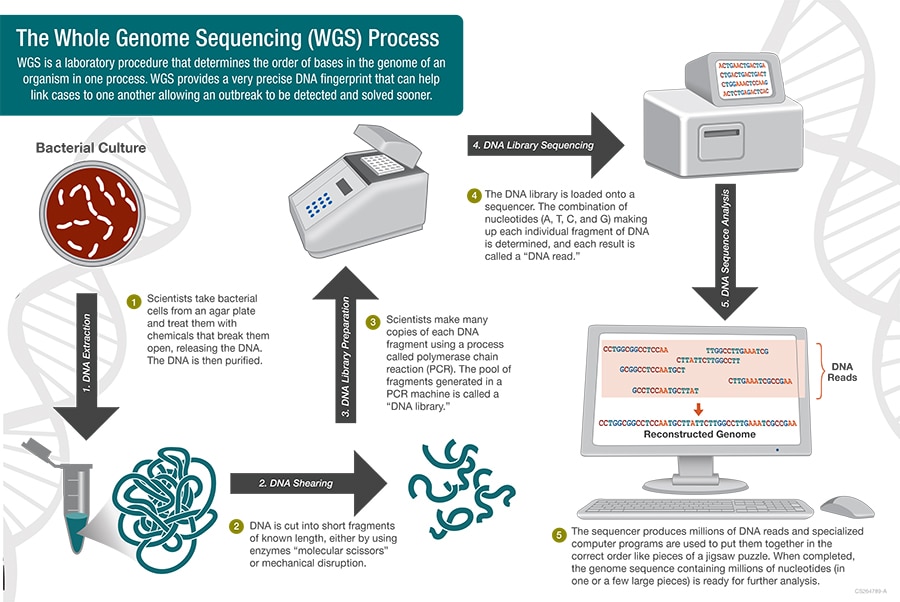At a glance
All organisms (bacteria, plant, and animal) have a unique genetic code that is composed of the nucleotide bases A, T, C, and G. Whole genome sequencing (WGS) is a technology that identifies the unique sequence of bases in an organism, also known as its DNA.
How Does Whole Genome Sequencing Work?
For scientists to preform WGS, they must first capture the genetic material (or DNA) from an organism. After collecting the DNA, it's then prepared for sequencing through a series of steps. Once sequencing is completed, scientists are able to analyze the information and identify unique DNA fingerprints. For PulseNet, the DNA from bacteria is sequenced to identify foodborne outbreaks in the United States, and abroad.

- DNA Shearing: Scientists use specific materials to cut DNA into pieces that are small enough for the sequencing machine to read.
- DNA Barcoding: Unique identifiers are added to DNA pieces in order to separate each organisms genetic code.
- DNA Sequencing: The DNA from different bacteria are combined and put into the sequencing machine. This machine identifies the nucleotide bases that make up the DNA fingerprint of each bacteria.
- Analysis: Scientists use computer's and software tools the compare the DNA fingerprints and identify differences.
Disease Detection
PulseNet and public health scientists use WGS to to identify foodborne outbreaks, and to learn why some bacteria make people more sick or are more resistant to antibiotics than others. WGS is now the standard PulseNet method for investigating and detecting foodborne outbreaks associated with bacteria such as Shiga toxin-producing E. coli (STEC), Salmonella, Vibrio, and Listeria.
Since being launched, WGS in public health laboratories has improved surveillance for outbreaks and enhanced the ability to detect trends in foodborne infections and antimicrobial resistance. The DNA fingerprints provide precise information to identify outbreaks sooner; before PulseNet it could take up to 39 days to identify an outbreak, now, an outbreak can be identified in about 16 days.
Whole Genome Support in Laboratories
PulseNet established the structure to support WGS in public health laboratories though:
- Training laboratory scientists to preform sequencing
- Purchasing equipment and supplies
- Updating data software and systems
There are currently 83 US laboratories and over 100 international laboratories on the PulseNet network. The implementation of WGS was made possible through collaborations with CDC's Advanced Molecular Detection Office, Food Safety Office, and Antimicrobial Resistance Solutions Initiative.
As the use of whole genome sequencing expands, CDC’s national surveillance systems and laboratory infrastructure must keep pace with the changing technology. With modernization, CDC and its public health partners can continue to successfully detect, respond to, and stop infectious diseases. Whole genome sequencing is a fast and affordable way to obtain detailed information about bacteria using just one test. Together, we can ensure rapid and less costly diagnoses for individuals and collect the evidence needed to quickly solve and prevent foodborne outbreaks.
